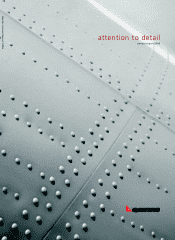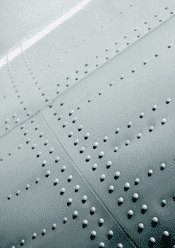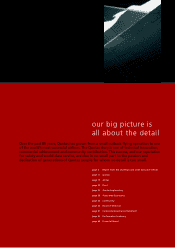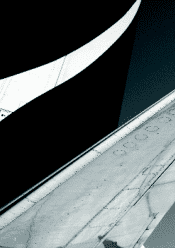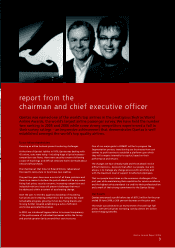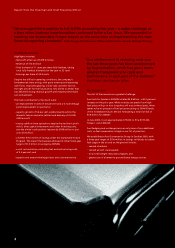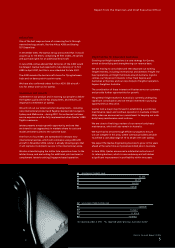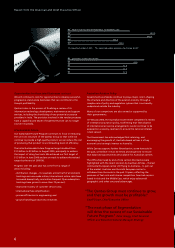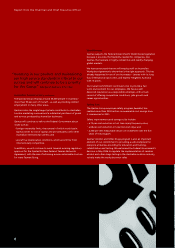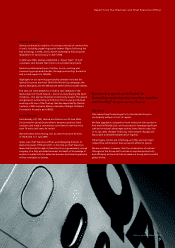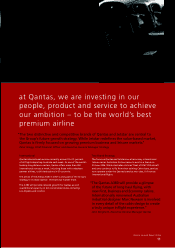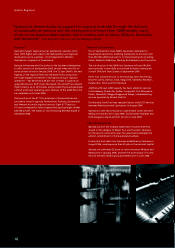Qantas 2006 Annual Report Download - page 8
Download and view the complete annual report
Please find page 8 of the 2006 Qantas annual report below. You can navigate through the pages in the report by either clicking on the pages listed below, or by using the keyword search tool below to find specific information within the annual report.
688.5
648.4
343.5
428.0
20.0
17.0
17.0
17.0
PROFIT FOR THE YEAR ATTRIBUTABLE TO MEMBERS ($M)
DIVIDENDS (CENTS PER SHARE)
06*
05*
04†
03†
02†
06
05
04
03
02
*
As reported under A-IFRS †As reported under previous Australian GAAP
Opportunities for Associated Businesses continued
We will continue to look for opportunities to develop successful,
progressive, stand-alone businesses that can contribute to the
Group’s profi tability.
Qantas is also in the process of fi nalising a review of its
information technology development, maintenance and support
services, including the shortlisting of two potential outsource
providers in India. The providers involved in the tender processes
have a capability and depth of expertise that we can no longer
source in Australia.
A Sustainable Future
Our Sustainable Future Program continues to focus on reducing
the unit cost structure of the Qantas Group so that while we
continue to provide a high quality product, we can reduce the cost
of producing that product to world-leading levels of efficiency.
The initial Sustainable Future Program target doubled from
$1.5 billion to $3 billion in August 2005, principally to address
the impact of rising fuel costs. We achieved our fi rst target of
$1.5 billion in June 2006 and are on track to achieve the revised
target by the end of 2007/08.
Progress over the past year has come from a range of
areas including:
• distribution changes – for example, almost half of all domestic
bookings are now made online, international online sales have
increased dramatically, and online Frequent Flyer redemption
bookings have grown to more than 70 per cent;
• improved recovery of customer service costs;
• international fare simplifi cation;
• process efficiencies in engineering; and
• ground handling productivity initiatives.
Australian Aviation Policy
Governments worldwide continue to play a major role in shaping
the structure and direction of the aviation industry through a
complex mix of policy and regulation systems that is not readily
understood outside the industry.
Many of our competitors are also owned or supported by
their governments.
In February 2006, the Australian Government completed its review
of international aviation policy, reaffirming that liberalisation
of international air service arrangements would continue to be
assessed on a case-by-case basis to ensure the national interest
is best served.
The Government has acknowledged that retaining, and
encouraging the growth of, Australia-based airlines is of key
economic and strategic interest to Australia.
While Qantas supports further liberalisation, as we have said in
the past, we believe it must be timed and sequenced to ensure
that balanced opportunities are available for Australian carriers.
The difficulties faced by end-of-line carriers like Qantas were
highlighted with the recent decision by Austrian Airlines – the last
continental European carrier still fl ying to Australia – to pull out
of the market. Austrian was the sixth European carrier to
withdraw from the route in the past 10 years, refl ecting the
pressures of fuel costs and intense competition from hub carriers
based in Asia and the Middle East, which enjoy substantial
geographic and other structural advantages.
Report from the Chairman and Chief Executive Officer
“The Qantas Group must continue to grow,
and that growth must be profi table.”
Geoff Dixon, Chief Executive Officer
“The next phase of Segmentation
will drive the success of our Sustainable
Future Program.” Peter Gregg, Chief Financial
Officer and Executive General Manager Strategy
6

